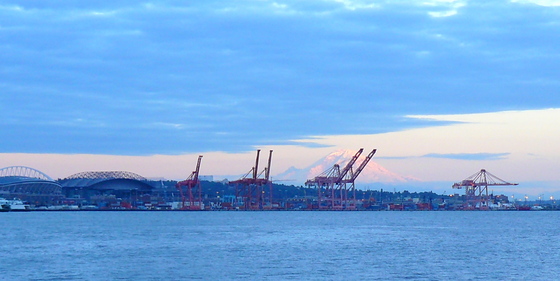It's tempting to confuse geography with destiny.
We are fortunate, here on the northwest coast of North America. Our climate is mild, and our biggest volcano is dormant. Our harvest this fall--apples, cherries, grapes--is bountiful. Our waters teem with big fish, our ports thrive with commerce. In fact, we live in an idyllic bubble, protected somehow by the spirit of our sacred salmon and our magic mountain. The rest of the world is dark, dangerous and unpredictable.
Geography and politics often interconnect, sometimes on the battlefield, sometimes at the ballot box, sometimes on the world's dinner plate. It's worth remembering that the Arab Spring uprising wasn't a spontaneous, pro-democracy demonstration but a protest against food shortages.
Two examples this year of natural phenomena that affect our global, interdependent food systen, with very different results. One on land, one by sea.
First: the oceans. Earlier this year, there were storms off the coast of Peru. As a result, the anchovy harvest dropped. Anchovies, sojme 20 percent of all global fishing, are used in fish oil and fish meal, not just in Caesar salads and as pizza toppings; they're also a key ingredient in the feed for farmed salmon.
The shortage in fish meal came on the heels of a second meteriological event beyond human control, the drought in America's heartland. As a result, the corn crop dropped by almost 50 percent, and the price of corn almost doubled this year.
Those perky yellow ears of corn on the grocery shelves are deceiving; the vast majority of America's corn is used for ethanol, animal feed and sweeteners. One reason that American beef is significantly more expensive this year than last, of course, is that much of this year's vastly reduced corn crop is being diverted from feed lots to distilleries, distilleries which produce ethanol for fuel, aside from the conversion of corn to high fructose corn syrups as industrial sweeters
Parenthetically, because it's getting so much more expensive to fatten cattle with grain, some feed lots have supplemented their diets with vast quantities of out-of-date candy, according to an article in Huffington Post, because it contains corn-based sweeteners.
Meanwhile, with fewer cows shuffling to their fate at the kill line, you'd think there would be more buyers for lower-priced pork. Hog farmers, though, can't afford the feed either; they're slaughtering their herds prematurely, putting the carcasses into cold storage, and hoping for the best.
Now back to the fish farms, most of which are in the icy waters off Norway and Scotland. Because of the smaller anchovy catch, it's becoming more expensive to raise salmon, even as the demand for farmed fish is skyrocketing. This year, water temperatures in the North Atlantic have been a couple of degrees warmer than normal. This has had a big affect on the appetite of salmon, which has led to record harvests, up 30 percent this year.
The result of the glut, despite the greater expense of feeding the salmon, is a price drop. As a result, consumption of farmed salmon in Europe is up 25 percent, even in countries in recession. It's up 67 percent in Russia, up 85 percent in Brazil (where the fish comes from a strong Chilean industry) figures show Russian salmon consumption is up 67 percent. Even China, which doesn't have a tradition of eating fish filets, is eating more salmon.
The American consumer, whose diet relies more on beef than fish, will simply end up paying more for dinner. The big winners in all this are the international banks (who finance the Peruvian anchovy fleets, for example) and the low-profile international commodities brokers: the Swiss firm Glencore is very big in wheat, ADM in corn, Louis Dreyfus in rice, Cargill in just about everything. Glencore told The Guardian last week that the anchovy shortage "is good for business." These are the outfits who compete fiercely for the business of buying up the food supply (whatever the price) and moving it to market. It's an almost unregulated, global industry with trillion-dollar profits, which makes money in good weather and bad, and it's the reason you could soon be paying an extra buck for your burger.
We can't avoid it. Not even in Seattle.
Note: this post was also published today on Crosscut.com

Leave a comment